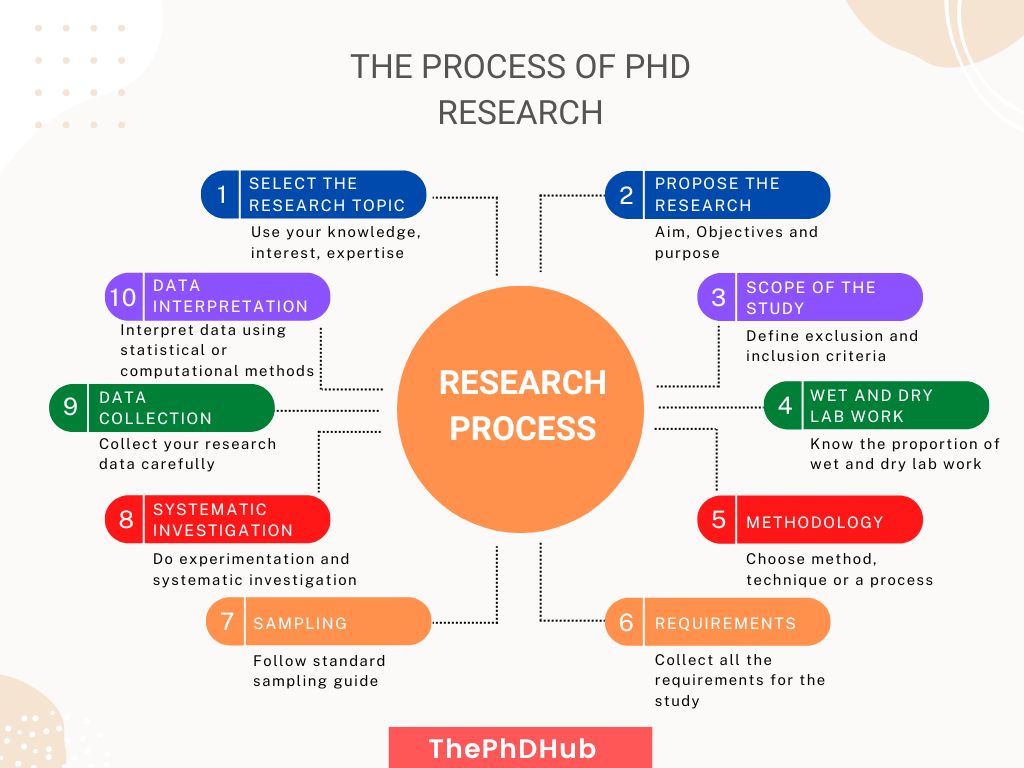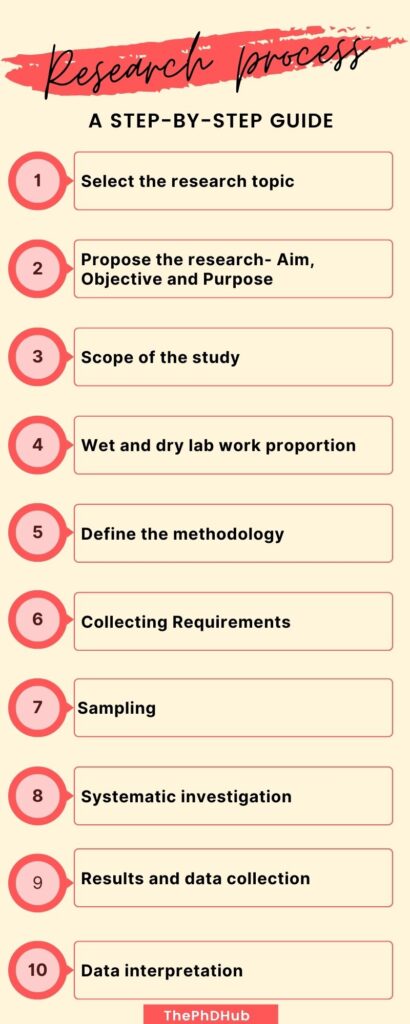“PhD/doctoral research is a process driven by sample collection, wet and dry lab work and data collection. It’s important for students to know the step-wise process of PhD research. Let’s understand the various steps in research.”
“Research–” the word has crucial importance in academics. Hence, the paramount level of the academic field is a research-driven process that is awarded to someone for achieving new knowledge.
I am talking about the PhD, which people often call a “doctorate” which is the honor and prestige in any education system. Every subject and interdisciplinary field is now eligible for PhD, which was only awarded to a few in a few subjects in history.
The fortune– right now is that anyone can apply for a PhD and can enroll but unfortunately that all can’t get it and meanwhile stuck. The biggest reason behind it is that they don’t know the exact “process of research.”
It’s understandable and convincing, after all, they (and you) are only students, students who just got their masters a couple of months or a year ago. It is indeed the university’s or guide’s responsibility to let them know about how to do research.
Research is a systematic process from selecting a purpose to getting output as data. As I said, students fail to understand that and so fail miserably in their doctorates. Although, if you are on this article, you landed on the right page.
In this article, I will explain to you the process of research for PhD in a stepwise manner so that you can understand how to do it. Trust me, it’s gonna be fun and you will learn a decent thing. Stay tuned.
Related article: What is PhD?- History, Definition, Origin, Requirement, Fees, Duration and Process.
Steps in the PhD Research Process
The research process for PhD is a systematic investigation that starts with a definite purpose and ends with significant and important data. Let’s dig into understanding starting with steps.
Keep in mind that we are elaborately explaining the process of research, not the process and steps of getting or doing PhD.
- Select the research topic
- Propose the research- aims, objective and purpose
- Postulate the scope of the study
- Wet and dry lab work proportion
- Define the methodology for the topic
- Collecting requirements
- Sampling
- Doing systematic investigation
- Collecting data
- Interpreting data
Diagram of the research process

PhD Research Process:
Select a research topic
Most students don’t think so, but research topic selection is a crucial step in crafting the research for your PhD. If you made a mistake at this stage, you will have to suffer a lot during your entire journey.
Keep in note that you can not change your topic, which would be your thesis title later on, anytime and it’s a lengthy and hard process. So be careful what to choose. However, let me tell you that it isn’t that hard, actually.
Using your present knowledge, your expertise, experience— if any, interest and most importantly your guide’s knowledge you can select a research topic. When you search for any topic, make sure to test it on these parameters.
Another important point is that ‘read’. Read as much literature as you can. Read literature, by keeping in mind what output the original researchers are getting. Do an assessment of whether the results are rare, easy to achieve, most common or lengthy to get.
Get an expert’s help, and ask your senior, co-guide or other scientists about your selection. Discuss the pros and cons of the topic you have chosen.
Propose the research
Now it’s time to propose your research by stating the aim, objectives and purpose. The research must be purposeful to fill the knowledge/ research gap. The sole purpose here is to achieve different/separate milestones while heading to your “Aim.”
Most importantly the purpose of your research should solve some problem for a society, a group of people or mankind. Prepare an excellent research proposal, afterward.
The scope of the study
It’s paramount to set boundaries. Let me tell you the bitter truth that your chances of defending your thesis successfully depend on how you set your boundaries— means the scope.
Postulate the scope of the study— the inclusion and exclusion criteria for your research, the sample size and the conditions of research. However, note that the scopes should not be too small and that can’t justify your work.
Wet and dry lab work proportion
Next, you have to first understand the exact proportion of wet and dry lab work you have to do. Wet lab work is research is done in a laboratory while dry lab work is research is done in a system or computer lab– the simple and straightforward meaning.
What are the consequences if the proportion isn’t balanced?
See, if you are a lab person– more a technical fellow, and if you have to do a lot of computational, statistical and mathematical analysis, you can’t deliver strong results. Vice versa, computational analytics personnel can’t do a lot of wet lab work.
In each condition, the researcher would be stuck. So better to know how much wet and dry lab work needs to be done.
Define methodology
Yet another critical parameter that directly impacts your ‘defense chances’ is the methodology. The methodology is a process, collection of techniques or system you have chosen to defend your research topic.
They get or do not get results because they have selected this method.
We get or do not get results because we have selected that method.
These two simple sentences show the importance of the methodology and how it affects your thesis defense. Again, methodology sets some boundaries for your research and eventually gives you the power to chase.
Select a methodology in which you have the knowledge, experience and sheer expertise. It must be in the range of your topic. Keep these things in mind for methodology selection.
- The importance of the selected methodology for your topic
- The availability of the methodology at your place
- The difficulty level
- The accuracy of the methodology
- Sensitivity and specificity of the methodology
- The cost of methodology
Collecting requirements
Now everything is nearly done for your research, you are just one step ahead to start doing actual research. You have to–- in the next step, order and collect the requirement to conduct the research. For example, chemicals, glassware, plasticware, or anything else which is required.
Sampling
In the next step, you have to start doing research by initiating the sampling process. One more time, you have to read and document many things related to sampling. You have to take care of sampling technique, time, transportation, consent— if required, and ethical approval— if required.
Remember, if you are dealing with human, animal or biological samples, you have to need an expert, prior permissions and transportation facilities for the sample. Do take care of all these things.
Systematic investigations
You have selected a methodology, and collected utilities and samples. Now, you can start systematic investigations, meaning– actual experimentation. Do experiments, set up your working SOP and optimize the protocols or process.
Start experimenting with samples only when you get tentative results in the optimization part. You can club sample processing if you have the expertise or do single experiments with each sample.
Note down the changes, optimization, process and experiments you perform every day. Don’t forget to note down every minute results.
Data collection
A crucial part of everyday research is data collection. Note down, and take pictures or videos of the results you get. Along with that note down the results– something unusual, different or pattern you observed.
Data interpretation
The interpretation segment is also significant and must be handed over to the expert– meaning your guide. However, if someone has a deep knowledge of the subject, just like me can perform the interpretation part too.
To interpret the data various computational, and mathematical and statistical analysis has been performed– For example, Mean, Median, Mode, P and student tests are some of the common and popular statistical analyses.
For some crucial research— tools like bioinformatics and other computational analysis are also performed. The final results should be in numbers, figures or something quantifiable, in most cases.
PhD research process Flowchart

Wrapping up:
This is a broad overview of the steps in the PhD research process. I know everyone knows how to do research, but knowing the exact pattern would certainly help to understand it at a micro-level.
When you learn things at such a micro level, your chances of getting success increase. I hope this article makes sense for, at least newbie fellows who have just entered the world of uncertainty— the PhD.
Why is this important? Let me tell you, these steps of research you can use to prepare your GANTT chart for research and monitor your every research goal. Want to know about the GANTT chart? Read this article.




